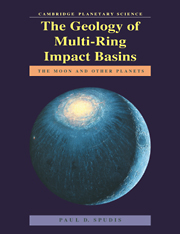Book contents
- Frontmatter
- Contents
- Preface
- 1 The multi-ring basin problem
- 2 From crater to basin
- 3 The ‘archetype’ basin: Orientale
- 4 An ancient basin: Nectaris
- 5 A modified basin: Crisium
- 6 A transitional basin: Serenitatis
- 7 The largest basin: Imbrium
- 8 Geological processes in the formation of lunar basins
- 9 Multi-ring basins on the terrestrial planets
- 10 Multi-ring basins and planetary evolution
- References
- Index
7 - The largest basin: Imbrium
Published online by Cambridge University Press: 12 October 2009
- Frontmatter
- Contents
- Preface
- 1 The multi-ring basin problem
- 2 From crater to basin
- 3 The ‘archetype’ basin: Orientale
- 4 An ancient basin: Nectaris
- 5 A modified basin: Crisium
- 6 A transitional basin: Serenitatis
- 7 The largest basin: Imbrium
- 8 Geological processes in the formation of lunar basins
- 9 Multi-ring basins on the terrestrial planets
- 10 Multi-ring basins and planetary evolution
- References
- Index
Summary
The Imbrium basin (Figure 7.1) is probably the most studied multi-ring basin on the Moon. Prominently located on the lunar near side, west of Mare Serenitatis and east of the large maria Oceanus Procellarum (Figure 1.1), the Imbrium basin first attracted the attention of G.K. Gilbert (1893) in his historic analysis of lunar craters. Gilbert recognized the extensive pattern of radial texture associated with Imbrium and postulated that Mare Imbrium had formed by the collision of a large meteorite with the Moon. The impact origin of the Imbrium basin was also recognized by Dietz (1946), Baldwin (1949; 1963), Urey (1952), and Hartmann and Kuiper (1962). The landmark paper of Shoemaker and Hackman (1962) proposed a global stratigraphic system for the Moon based on the deposition of ejecta from the Imbrium basin as a marker horizon. The Imbrium impact was considered such a key event in lunar geological history that two Apollo missions (Apollo 14 and 15) were sent to landing sites specifically chosen to address problems of Imbrium basin geology.
Regional geology and setting
Imbrium is one of the youngest major basins on the Moon, but extensively flooded by mare basalt (Figure 7.1). Even so, as one of the largest lunar basins (main topographic rim 1160 km in diameter), it has an ejecta blanket so extensive that almost all of the near side may be dated relatively with respect to the time of the Imbrium impact (Wilhelms, 1970).
- Type
- Chapter
- Information
- The Geology of Multi-Ring Impact BasinsThe Moon and Other Planets, pp. 131 - 164Publisher: Cambridge University PressPrint publication year: 1993



